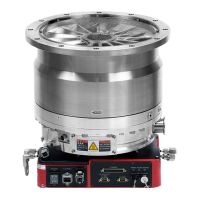STP-iS2207 Series Turbomolecular Pump
MT-89E-001-C
Page 23
INSTALLATION
3
3.2 Unpacking and installation
Check outer package for damage and that the delivery note corresponds to the purchase order. If the
STP pump is damaged, contact Edwards or their distributor.
Note: It is recommended to keep the packaging materials, such as the corrugated fiberboard
container and cushioning material for possible reuse.
WARNING
The STP pumps are heavy products. Observe national laws/regulations, safety
standards and manufacturers instructions when lifting the STP pump.
Lifting devices must be used when lifting or moving the STP pump.
The STP pumps are heavy products (Refer to Section 2, "TECHNICAL DATA" for the mass of the
STP pump). Use a crane or other appropriate means sufficient enough to withstand the load when
lifting the STP pump of 18 kg or more.
Lift the STP pump with eyebolt, eye nut or a similar tool that uses the fitting hole attached to the inlet
port flange. When lifting the pump, use 2 or more ropes. (see Figure 11)
A crane, an eyebolt, and an eye nut due to lifting operations should withstand the load of five times or
more the weight of the STP pump, and rope should be seven time or more. Use an eyebolt, or eye
nut which confirms to ISO03266.
Always lift the STP pump in stable places free of excessive shock or vibration to prevent it from
shaking or dropping.
Care should be taken not to scratch the flange of the STP pump. Before installing the STP pump,
check that there are no scratches on the surface.
Eye nut size
Flange type
M8 ICF253 / ICF305
M10 ISO200F / ISO250F
M12 VG200 / VG250
Figure 11 - Example of lifting the STP pump
Table 2 - Eye nut size

